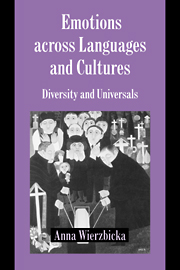Book contents
- Frontmatter
- Contents
- List of figures
- Acknowledgments
- List of abbreviations
- 1 Introduction: feelings, languages, and cultures
- 2 Defining emotion concepts: discovering “cognitive scenarios”
- 3 A case study of emotion in culture: German Angst
- 4 Reading human faces
- 5 Russian emotional expression
- 6 Comparing emotional norms across languages and cultures: Polish vs. Anglo-American
- 7 Emotional universals
- Notes
- References
- Index
4 - Reading human faces
Published online by Cambridge University Press: 22 August 2009
- Frontmatter
- Contents
- List of figures
- Acknowledgments
- List of abbreviations
- 1 Introduction: feelings, languages, and cultures
- 2 Defining emotion concepts: discovering “cognitive scenarios”
- 3 A case study of emotion in culture: German Angst
- 4 Reading human faces
- 5 Russian emotional expression
- 6 Comparing emotional norms across languages and cultures: Polish vs. Anglo-American
- 7 Emotional universals
- Notes
- References
- Index
Summary
The human face: a “mirror” or a “tool”?
The current debate on facial expressions is sometimes cast in terms of a choice between two opposing views: human faces as “read-outs” of inner emotions (e.g. Ekman 1972, 1989, 1994a and b; Izard 1971, 1977, 1994, 1997) vs. human faces as “social signals” (e.g. Fridlund 1994, 1997). By using the term “reading”, I am not in fact opting for the “Emotional Expression Approach” as against the “Social Communicative Approach” (Chovil 1997). I believe that both these conflicting positions embody part of the truth, but only part.
Ekman's position can be illustrated with the following quote:
The same facial expressions are associated with the same emotions, regardless of culture or language … There are some facial expressions of emotion which are universally characteristic of the human species … While facial expressions of emotion will often be culture specific because of differences in elicitors, display rules and consequences, there is also a pan-cultural set of facial expressions of emotion … The evidence now proves the existence of universal facial expressions … Regardless of the language, of whether the culture is Western or Eastern, industrialized or preliterate, these facial expressions are labelled with the same emotion terms: happiness, sadness, anger, fear, disgust and surprise.
(Ekman 1980: 137–8)And more recently (Ekman 1992a: 175): “The strongest evidence for distinguishing one emotion from another comes from research on facial expressions. There is robust, consistent evidence of a universal facial expression for anger, fear, enjoyment, sadness, and disgust”.
- Type
- Chapter
- Information
- Emotions across Languages and CulturesDiversity and Universals, pp. 168 - 215Publisher: Cambridge University PressPrint publication year: 1999



